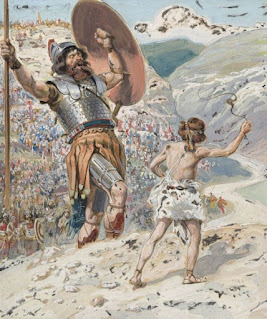David, Goliath, and Archaeological Evidences
Many people are familiar with the story of David and Goliath in one form or another, often without many biblical details. Those details help support the fact that it is not just a Sunday School story with the moral of trusting God, but also a historical narrative.
For example, history and archaeology show that a sling was a formidable and accurate weapon favored by shepherds and poor people. He did not need to get as close to Goliath as paintings depict! 1 Samuel 17:40 mentions that David took five smooth brook stones, their ammunition of choice. We have not only the eyewitness account in the Bible, but fascinating corroborating evidences from archaeology.
 |
| David Slings the Stone, James Tissot, c. 1896-1902 |
David and Goliath is so familiar, that many, sadly, dismiss the account as fable, along with the rest of Scripture. But what is the evidence? Does archaeology have anything to say about the characters and events of some of the most well-known verses in the Bible? This article explores some surprising supporting evidence that has been unearthed by archaeologists in recent years. Such evidence demonstrates beyond doubt that the events of David’s giant slaying are consistent with the archaeological record.The following seven evidences are not direct evidence for the existence of Goliath, but are nevertheless consistent with the biblical account, so they provide valuable cultural background for the David vs Goliath account.
You can read all of this extremely interesting article by digging your way to "Goliath—the BHG: Seven archaeological evidences for the biblical giant."